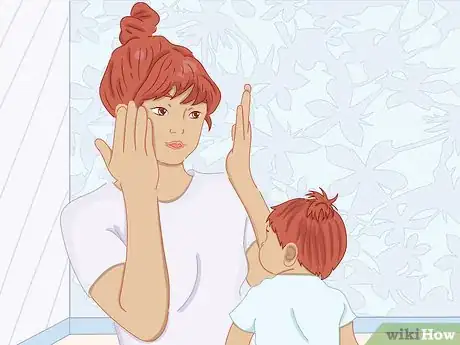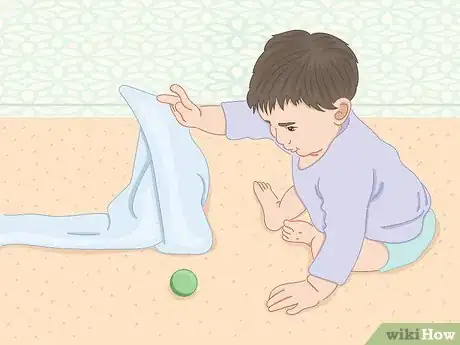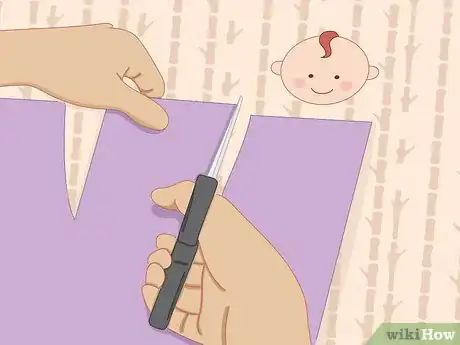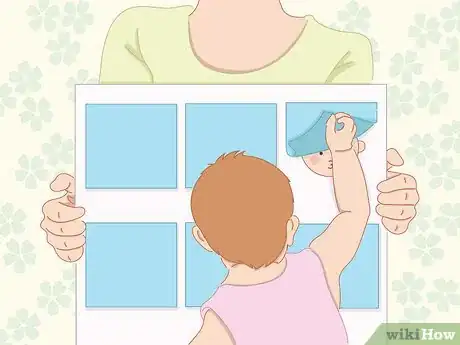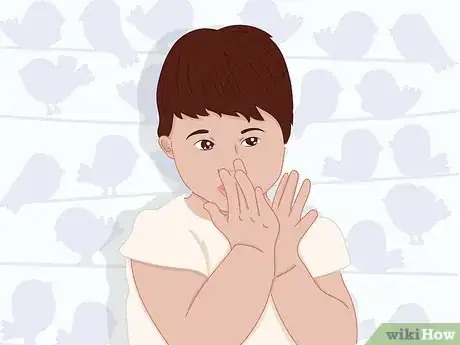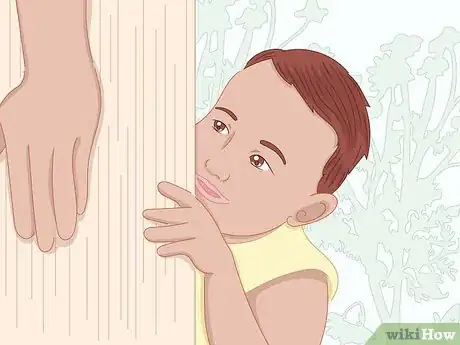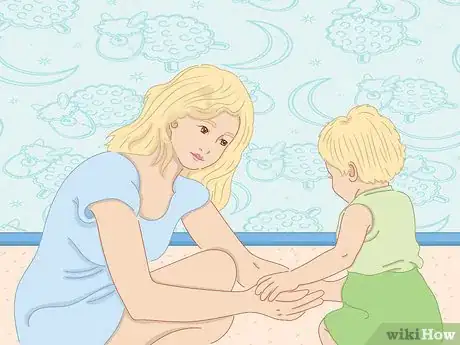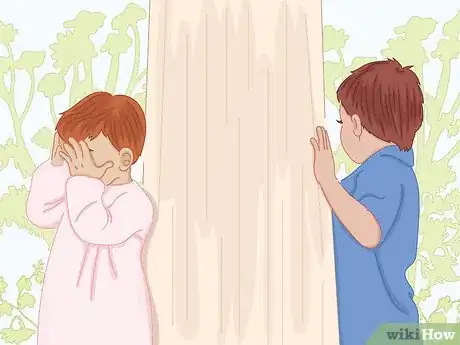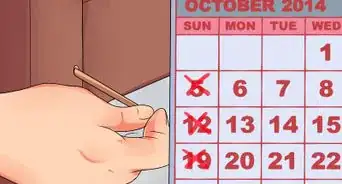This article was co-authored by wikiHow staff writer, Jessica Gibson. Jessica Gibson is a Writer and Editor who's been with wikiHow since 2014. After completing a year of art studies at the Emily Carr University in Vancouver, she graduated from Columbia College with a BA in History. Jessica also completed an MA in History from The University of Oregon in 2013.
This article has been viewed 61,750 times.
Learn more...
When you're a baby, playing is work! Games like peekaboo not only make your baby laugh, but help the baby learn about the world and its senses. By playing, babies gain self-awareness and critical social skills. The more you play, the more your baby will learn and grow!
Steps
Playing Peekaboo with a Baby Less Than Six Months Old
-
1Make sure your baby is comfortable. You’ll never get your baby to sit still for a game of peekaboo if it’s hungry, tired or wet. Feed your baby before you play and make sure it takes a nap. Change its diaper if you need to.
- Peekaboo can be overwhelming for a baby that is already agitated. You’re baby is likely to get upset during peekaboo if all its needs are not met prior.
-
2Get your baby’s attention. For your baby to get the maximum benefit from a game of peekaboo, you’ll need it to make eye contact with you. You can get your baby’s attention by making a few strange sounds with your mouth or making funny faces. Try sticking out your tongue or making a distracting sound. Everything’s new to a baby, so if it hears you make a sound that it’s not used to or sees you make a face it hasn't seen before, it will be transfixed by you.
- Make sure not to make sounds that are too loud or faces that are too scary. You don’t want to scare your baby.
- Making eye contact with your baby helps it to develop social skills and prepares it to connect with people in the world.
Advertisement -
3Hide your face. Cover your face with your hands or drape a towel or cloth over your face. Remember that to the baby, you’re not just hiding, you’re gone. At this stage of development, babies haven’t developed an understanding of object permanence. Object permanence means that an object (you) is still there even when the baby can’t see it. For this reason, the first few games of peekaboo can be a bit shocking to the baby.[1]
- You can ease your baby’s mind by talking to it while you’re hiding. You can say something like “Where’d mommy go? Where is she?”
- You can also hide yourself behind a piece of paper, a book or anything else that you have around.
-
4Reveal your face. Uncover your face and let out an excited “peekaboo!” Try showing your baby a variety of faces to see what it likes. For example, your baby might like a big smile or sticking your tongue out while scary faces or yelling "peekaboo" loudly might scare it.
- Make sure not to hide behind your hands for too long or your baby might become distressed, wondering whether or not you’re going to return.
- Watch for signs that your baby may be overwhelmed. Peekaboo can be mind-blowing for a baby. If it turns its head to side or makes a face like it’s about to cry, you may want to wait a while before playing again.
-
5Play peekaboo with a toy. If your baby is between 4 and 6 months old, it's starting to develop object permanence. This means you can try hiding one of their favorite toys and letting them find it. When the baby finds the toy, remember to say something like "You found it!"[2]
- For example, take one of the baby's stacking rings and hide it under a blanket. Let the baby try to pull the blanket up or away to reveal the ring. Reward the baby with lots of verbal praise when it does this.
-
6Repeat the game. Babies learn through repetition. Play peekaboo as much as you can. At first, your baby will be completely surprised that you reappear after you hide in your hands. After a while, your baby will start to suspect that you will reappear. They’ll be delighted when you prove them right.
- The baby learns to deduce that because you always reappear when you hide your face, you’ll probably do the same thing this time.
- While the baby doesn’t yet understand that you’re there the whole time, it forms a hypothesis that you will reappear. The baby is introduced to analytical thinking.
Playing Peekaboo with a Baby Over Six Months Old
-
1Draw pictures of people with various expressions on sturdy pieces of cardboard. These will be your peekaboo faces. Make your pictures with happy faces, sad faces,grumpy faces and and any other expression you can think of.
- At this point in your baby’s development, it’s starting to differentiate between identities. The baby is gaining a sense of identity and learning to compare its own identity to others.
- Seeing faces with different emotions will introduce your baby to social cues so he’ll be able to better understand how people feel.
-
2Cut a few rectangular pieces of cloth. Make sure the pieces of cloth are long enough to completely cover the faces that you have drawn. Glue the pieces of cloth above the faces on the cardboard. There should be a flap of cloth that can be lifted to reveal the face.
- Give the glue a little bit of time to dry before showing it to your baby.
-
3Have your baby lift the flap. Choose one of your cards and show it to your baby. Have your baby lift the flap to reveal the face. When it does, say, “peekaboo!” Your baby will be excited to see what new faces are on different cards.
- Your baby is beginning to understand the concept of object permanence. Creating an interactive game of peekaboo encourages the baby to explore its surroundings for hidden surprises.[3]
- The baby is learning to do research to find answers. It deduces that to see the funny picture, it will have to do the work of lifting the flap.
- You may have to show the baby how to lift the flap a few times before it understands what to do.
-
4Keep playing the game. Your baby will likely want to play the game over and over again. Your baby will be excited to lift the flap and discover the face underneath every time. Searching for the picture and finding it will give your baby a sense of accomplishment. They’ll feel like they solved the riddle and were rewarded with the picture.[4]
- Pop-up books are popular with children for the same reason peekaboo is.
- You can make new cards periodically to keep the game fresh.
-
5Encourage your baby to play. As your baby gets older, it will become more interactive with peekaboo. Try covering your baby's face with a light cloth or towel and say, "Where's baby?" Pull the blanket away and say, "Boo!" Keep doing this until your baby begins to tug away the blanket in anticipation.[5]
- At first, your baby may just wiggle or squirm under the cloth. Eventually, it will begin pulling away the blanket and may even say, "Boo!"
Graduating to Playing Hide And Seek with your Toddler
-
1Hide. Have your toddler close his eyes and count to ten while you find a place in the room to hide. If your toddler can’t count all the way to ten, you can just yell that you’re ready when it’s time for them to look for you.
- Make sure to hide close by. Toddlers are at the stage in their development where they want to explore and socialize but they can experience separation anxiety if you’re too far away. They need you to be their “home base”.
-
2Have the toddler search for you. Your toddler is learning to explore their surroundings on foot. The freedom of being able to walk around is new to your toddler. Playing a simple game of peekaboo may not excite them as much as being able to personally search for you.
- Your games of peekaboo should become more interactive as the child grows. The child should be able to experiment with the new skills they learn as they mature. Hide and seek is an evolution of peekaboo that allows the child to use their new-found mobility.
-
3Say “You found me!” When the toddler finds you, reward them by excitedly telling them they found you. Congratulating your toddler for finding you serves as positive reinforcement for them. It teaches them to get excited about searching out answers.[6]
- As they grow, they’ll look forward to solving more complex puzzles.
- You want your toddlers to take pride in finding you so that they’ll take pride in meeting other challenges later on in life.
-
4Encourage your toddler to play hide and seek with other toddlers. You toddler is at a place in their development where they’re starting to seek out social interaction. Teach them to play with other kids at an early age so that they grow up well adjusted socially.
- Set up play dates with other families with toddlers.
- Make sure to stay close by to keep an eye on the toddlers.
Warnings
- Make sure to say peekaboo excitedly but not too loudly or your could scare your child.⧼thumbs_response⧽
- Remember that babies can get overwhelmed the first few times that you play peekaboo with them. They actually think that you’ve disappeared which can be scary for them.⧼thumbs_response⧽
Things You'll Need
- Cardboard
- A pen
- Cloth
- Scissors
- Glue
References
- ↑ http://www.bbc.com/news/health-24553877
- ↑ https://www.cdc.gov/ncbddd/actearly/pdf/parents_pdfs/milestonemomentseng508.pdf
- ↑ http://www.babycenter.com/0_lets-play-peek-a-boo-picture-greatest-hits_1498492.bc
- ↑ http://www.parentingcounts.org/information/timeline/peek-a-boo/
- ↑ http://teachmetotalk.com/2013/03/05/how-to-play-peek-a-boo-advice-for-parents-with-toddlers-with-developmental-delays/
- ↑ https://aeon.co/opinions/why-playing-peekaboo-with-babies-is-a-very-serious-matter
About This Article
To play peekaboo, start by getting your baby’s attention with a funny face or a distracting sound and make eye contact with them. Next, cover your face with your hands and say something like “Where’d mommy go? Where is she?” Then, uncover your face and say “Peekaboo!” in an excited tone of voice. Since babies learn through repetition, try to play the game often. Make sure not to hide behind your hands for too long, though, or your baby might become distressed! For tips on advancing the game as the baby gets older, read on!



